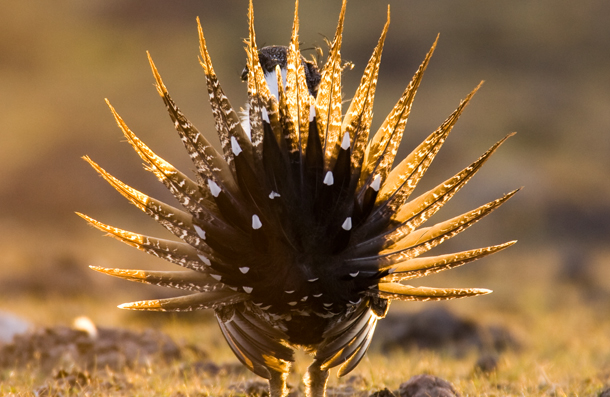Into the Sunset of the American West? Sage Grouse's Future Hinges on Politics & Federal Management Plans
Contact: Steve Holmer, 202-888-7490, sholmer@abcbirds.org

Greater Sage-Grouse, Noppadol Paothong
(Washington, D.C., September 8, 2015) By the end of this month federal authorities will make historic decisions that may dramatically change the landscape of the American West: whether to list the Greater Sage-Grouse under the Endangered Species Act (ESA) or to rely on management plans that are currently too weak to save the iconic bird.
“The grouse population has declined by 98 percent from its original numbers,” said Steve Holmer, Senior Policy Advisor at American Bird Conservancy. “Only an ESA listing, with the mandatory conservation efforts that would ensue, or scientifically-sound federal management plans will be enough to reverse this species' spiral toward extinction.”
“The Greater Sage-Grouse is an iconic species of the American West. The real question is whether we want the plains to be full of wildlife or full of power lines and oil wells. You can have some of both, but right now we are heading to a horizon filled with a lot of industrial infrastructure that will squeeze out the grouse,” he added.
“Many now believe that an ESA listing is not needed, and we at ABC would support that outcome — but only if the federal land management plans put forward by the Bureau of Land Management and the USDA Forest Service are significantly strengthened,” Holmer continued. “We would also want to see regular reviews of the species' population trend based on range-wide data to reassess the need to list the species in future – based on its current long-term decline.”
“The plans would need to be shown to be working or we would need to revisit the listing issue,” he added.
A major conservation effort has been initiated by states, agencies, and a range of stakeholders to support grouse recovery. These efforts have made significant progress on private working lands, but a significant portion of the grouse population depends on federal lands. While the recovery efforts are to be applauded, the current BLM and Forest Service management plans still allow new energy transmission lines and oil and gas leasing across the most important remaining grouse habitat.
“There's little chance of long-term recovery if sagebrush habitat continues to be lost, as would be permitted under these plans,” said Holmer.
The federal grouse management plans are expected to be finalized prior to the ESA listing decision. Because the majority of sage grouse and sagebrush habitat are found on federal lands within the purview of these plans, the management standards included in the plans are critically important. Studies have found that grouse avoid transmission lines and other tall structures such as wind turbines by a large margin due to the fact that birds of prey that target grouse might use them as perches. The wires also prevent movement of the species across the landscape because the birds tend to avoid crossing underneath them.
“We strongly support the federal planning initiative and efforts to engage private lands and landowners in grouse conservation,” Holmer said. “These are the right strategies to conserve the grouse and avoid endangerment. It would be a shame to see potentially precedent-setting conservation efforts fall short because too many loopholes for energy development were retained in the federal management plans.”
This decision comes at the conclusion of a 12-month moratorium on listing the grouse under the ESA, stemming from a congressional rider passed last year. “Some members of Congress are still attempting to prevent implementation of these new conservation plans and the listing of the grouse,” said Holmer. “The effectiveness of the plans is a major concern, but a still greater problem is the possible derailment of the entire grouse conservation effort due to political maneuverings.”
“We're urging people who care about this issue to contact government officials immediately,” he concluded.
# # #
American Bird Conservancy is the Western Hemisphere's bird conservation specialist — the only organization with a single and steadfast commitment to achieving conservation results for native birds and their habitats throughout the Americas. With a focus on efficiency and working in partnership, we take on the toughest problems facing birds today, innovating and building on sound science to halt extinctions, protect habitats, eliminate threats, and build capacity for bird conservation.


















































